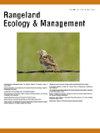东部红杉(Juniperus virginia L.)的影响北方大平原混交草草原林冠直径和林分盖度对地上生物量和组成的影响
IF 2.4
3区 环境科学与生态学
Q2 ECOLOGY
引用次数: 0
摘要
东部红杉(ERC) (Juniperus virginia L.)树木正在入侵整个大平原的草原。这种入侵对本地植物群落的生产、再生和多样性构成了威胁。本研究的目的是确定ERC冠层如何影响草本生物量的生产和组成。在直径0.1-10 m的ERC树树冠下和草地控制点的四个基本方向上放置方形样方(0.25 m2)。我们收集了326棵ERC树和240个草地控制点的草本叶面覆盖度和生物量估算值,共1381个样本。研究发现,随着ERC冠层直径的增加,ERC冠层下草本生物量呈指数型下降,冠层大于2 m的树木生物量减少63-97%。生物量随ERC林分冠层盖度的增加呈近似1:1的线性下降。各物种平均叶面盖度、植物区系质量指数、物种丰富度和本地物种丰富度均随ERC冠层直径的增大而减小。结果表明,ERC的入侵不仅减少了草本生物量,而且改变了植物群落的组成。这突出了ERC对草原控制的重要性,并为土地所有者提供了可应用于其个人经营的数据。为了维持或恢复原生草地,我们建议每5-10年通过规定的火灾和/或机械清除ERC。遵循这些管理策略,应该保持一个健康的草原系统。本文章由计算机程序翻译,如有差异,请以英文原文为准。
Impact of Eastern Redcedar (Juniperus virginiana L.) Canopy Diameter and Stand Canopy Cover on Aboveground Biomass and Composition in the Northern Great Plains Mixed-Grass Prairie
Eastern redcedar (ERC) (Juniperus virginiana L.) trees are invading prairies throughout the Great Plains. This encroachment poses a threat to native plant communities in terms of their production, regeneration, and diversity. The objectives of this study were to determine how ERC canopies impact herbaceous biomass production and composition. Square quadrats (0.25 m2) were placed in four cardinal directions underneath canopies of ERC trees ranging from 0.1–10 m in diameter and at grassland control locations. We collected herbaceous foliar cover by species and biomass estimates underneath 326 ERC trees and at 240 grassland control locations among two sites totaling 1381 samples overall. We found herbaceous biomass production underneath ERC canopies decreased exponentially with increasing ERC canopy diameter with 63–97% reduction under trees with canopies larger than 2 m. Also, biomass decreased linearly with increasing ERC stand canopy cover (%) at nearly a 1:1 ratio. Mean foliar cover for all species, Floristic Quality Index, species richness, and native species richness decreased as individual ERC canopy diameter increased. Results indicate that ERC encroachment is not only reducing herbaceous biomass production, but it is also altering the composition of plant communities. This highlights the importance of ERC control on grasslands and provides landowners with data that can be applied to their individual operation. To maintain or restore native grasslands, we suggest the removal of ERC through prescribed fire and/or mechanical removal every 5–10 years. Following these management strategies should maintain a healthy grassland system.
求助全文
通过发布文献求助,成功后即可免费获取论文全文。
去求助
来源期刊

Rangeland Ecology & Management
农林科学-环境科学
CiteScore
4.60
自引率
13.00%
发文量
87
审稿时长
12-24 weeks
期刊介绍:
Rangeland Ecology & Management publishes all topics-including ecology, management, socioeconomic and policy-pertaining to global rangelands. The journal''s mission is to inform academics, ecosystem managers and policy makers of science-based information to promote sound rangeland stewardship. Author submissions are published in five manuscript categories: original research papers, high-profile forum topics, concept syntheses, as well as research and technical notes.
Rangelands represent approximately 50% of the Earth''s land area and provision multiple ecosystem services for large human populations. This expansive and diverse land area functions as coupled human-ecological systems. Knowledge of both social and biophysical system components and their interactions represent the foundation for informed rangeland stewardship. Rangeland Ecology & Management uniquely integrates information from multiple system components to address current and pending challenges confronting global rangelands.
 求助内容:
求助内容: 应助结果提醒方式:
应助结果提醒方式:


